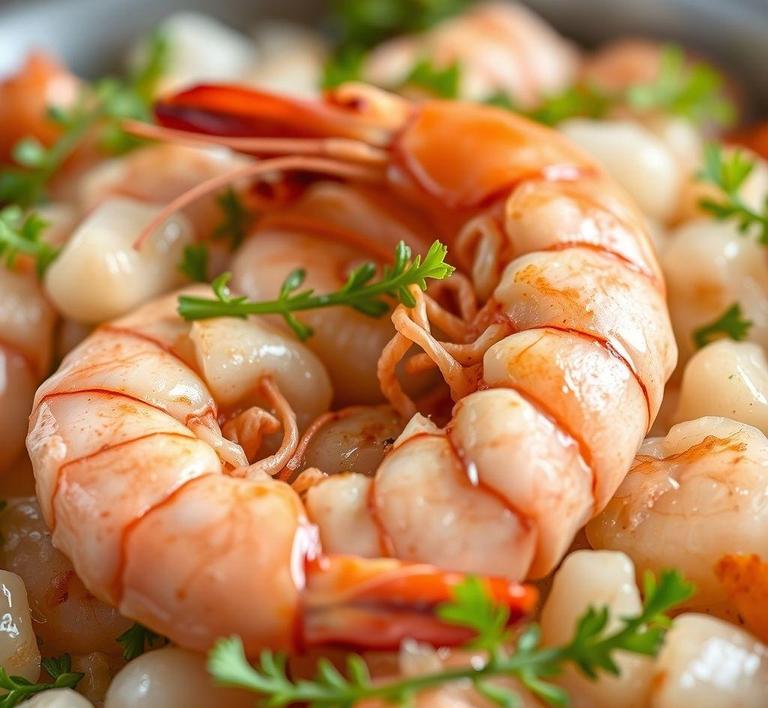If you’ve ever found yourself with leftover cooked shrimp and wondered whether you can safely refreeze them, you’re not alone! The good news is that it is possible to refreeze cooked shrimp, but there are a few important things to keep in mind to ensure it stays safe and tasty. Freezing and refreezing seafood, in particular, can be a little tricky, but with the right methods, you can extend the shelf life of your shrimp without sacrificing too much flavor or texture. In this guide, we’ll walk you through everything you need to know about safely refreezing cooked shrimp, from storage tips to how to maintain its quality.
Can You Refreeze Cooked Shrimp?

The short answer is yes, you can refreeze cooked shrimp, but there are some important factors to consider before doing so. While shrimp are highly perishable and need to be handled with care, freezing and refreezing them is not inherently unsafe-provided it’s done correctly. The key lies in how the shrimp were thawed in the first place and how quickly they were cooked after that thawing process.
When shrimp are initially frozen, they go through a process of ice crystallization. This alters their texture, but it’s a manageable change if they’re cooked right away after thawing. If you refreeze cooked shrimp, the freezing process happens all over again, which means ice crystals form within the shrimp once again. This can affect the texture, causing them to become mushy when thawed, which is often the main concern.
The USDA’s stance on refreezing cooked shrimp is based on the principle that they should not be left at room temperature for extended periods (no more than 2 hours). If they were thawed in the fridge and haven’t sat out too long, you can refreeze them safely. However, the texture may not hold up as well as it would if the shrimp had been frozen only once.
How To Refreeze Cooked Shrimp?
If you’ve made the decision to refreeze your cooked shrimp, here’s how to do it in a way that minimizes any negative impact on texture and flavor:
-
Cool the Shrimp Quickly:
After cooking, allow the shrimp to cool down to room temperature before freezing them again. However, don’t let them sit out for more than two hours to avoid bacterial growth. You can speed up the cooling process by spreading them out in a single layer on a baking sheet or tray.
-
Package Them Properly:
For the best results, you need to package your cooked shrimp properly to prevent freezer burn and preserve flavor. Use airtight containers or resealable freezer bags, ensuring that all the air is squeezed out. If you’re using a freezer bag, consider the technique of water displacement-place the shrimp in the bag, submerge the bag in water to force out the air, and then seal it tightly. This reduces the risk of freezer burn.
-
Label and Date the Packaging:
It’s easy to forget when you froze something, so be sure to label the container with the date of freezing. You can typically keep refrozen cooked shrimp in the freezer for up to 2 months, but the sooner you use them, the better the quality.
-
Thaw Correctly:
When you’re ready to use the shrimp, it’s important to thaw them safely. The best way is to place them in the refrigerator overnight. If you need them in a pinch, you can thaw them quickly under cold running water. Avoid microwaving them or thawing at room temperature, as these methods can further degrade the texture and increase the risk of bacterial growth.
Quality Impact
The most noticeable change when refreezing cooked shrimp is the impact on quality, specifically the texture. Fresh shrimp, when properly cooked and frozen, retain a certain firmness that gives them a satisfying bite. However, every time shrimp are frozen and thawed, their cell structure breaks down a little bit more, releasing moisture. This loss of moisture causes the shrimp to become soft and sometimes even mushy.
Additionally, when shrimp are refrozen, their flavor may diminish slightly, especially if they were not packaged well. The longer they stay in the freezer, the more they might develop freezer burn, which leads to a dry, unappealing taste and texture.
Refreezing can also introduce the risk of microbial contamination if the shrimp were not cooled and stored promptly after the first thaw. This could affect the flavor and potentially cause food safety concerns. That’s why it’s essential to follow proper thawing and storage procedures.
While refreezing cooked shrimp is technically safe if done properly, it is not without consequences. The texture and flavor will likely be compromised the more times the shrimp are frozen and thawed. Refreezing cooked shrimp can lead to a mushier texture and possibly diminished flavor, which might make them less appetizing, particularly in dishes where the shrimp’s natural texture and taste are the star of the show.
To maintain the best quality, it’s recommended to only freeze shrimp once, ensuring that they are cooked and cooled promptly before being stored in an airtight container. If you do choose to refreeze them, take extra care in packaging and labeling to minimize the loss of quality. Ultimately, if you want to enjoy shrimp at their best, it’s best to limit refreezing and consume them soon after the initial thawing.
Hope this comprehensive breakdown helps! If you have any specific questions about refreezing shrimp or need more details, feel free to ask!
Is It Safe To Refreeze Cooked Shrimp?
Refreezing cooked shrimp is a common question that many home cooks and seafood lovers ask, particularly when there’s a surplus of leftovers or a few shrimp that didn’t make it to the plate. The short answer is: yes, it’s technically safe to refreeze cooked shrimp, but only under certain conditions. Understanding how to safely handle and store shrimp can help you avoid compromising both the taste and the safety of your food.
Shrimp, like other seafood, is highly perishable, so it’s crucial to follow strict guidelines when freezing and refreezing. The USDA does allow you to refreeze cooked shrimp as long as it hasn’t been left out at room temperature for more than two hours. However, several factors must be considered to ensure that the shrimp retains its quality and doesn’t pose a health risk.
The main concern when refreezing shrimp is the potential for bacterial growth during the thawing and refreezing process. When food is thawed, bacteria that may have been present on it multiply at a rapid rate, especially if left at room temperature. Refreezing it can trap the bacteria back into the shrimp, which could lead to foodborne illness if not handled properly.
Additionally, refreezing cooked shrimp multiple times can degrade its texture, flavor, and nutritional value. When shrimp is frozen, thawed, and frozen again, the water inside the shrimp cells forms ice crystals that can rupture the cell walls. This process leads to a mushy or rubbery texture upon reheating.
Signs That Cooked Shrimp Should Not Be Refrozen
Not all cooked shrimp are suitable for refreezing, and there are some telltale signs that the shrimp has already gone bad or should not be refrozen under any circumstances.
- Off Smell: One of the most obvious signs that shrimp should not be refrozen is if it has developed a sour, ammonia-like, or unpleasant odor. This indicates that bacteria have begun to break down the shrimp, making it unsafe to eat. Even if the shrimp looks fine, a bad smell is a clear indicator of spoilage.
- Slimy or Sticky Texture: If the cooked shrimp feels slimy or sticky to the touch, it’s a sign of bacterial growth. This is another indication that the shrimp has gone bad and should not be refrozen or consumed. A normal cooked shrimp should have a firm, dry texture and should not feel tacky or overly soft.
- Discoloration: Cooked shrimp should retain its pink or orange color after cooking. If you notice any discoloration, such as a grayish tint or dark spots, this can indicate that the shrimp has started to spoil. Refreezing shrimp that has begun to lose its vibrant color will only make it worse.
- Signs of Freezer Burn: Freezer burn occurs when the shrimp is exposed to air in the freezer. It leads to dehydration, with white or grayish patches forming on the surface of the shrimp. While freezer-burned shrimp isn’t unsafe to eat, its texture and flavor will be compromised, and it’s best to avoid refreezing shrimp that shows these signs.
- Extended Time at Room Temperature: If cooked shrimp has been left out at room temperature for more than two hours, it should not be refrozen or eaten. Bacteria can multiply quickly at temperatures above 40°F (4°C), and even refreezing will not make the shrimp safe to eat again.
Common Refreezing Mistakes
When refreezing cooked shrimp, it’s easy to make a few mistakes that can impact both its safety and quality. Here are some common missteps to avoid:
- Refreezing Without Proper Storage: Storing cooked shrimp improperly before refreezing is one of the most common mistakes. Shrimp should always be placed in an airtight container or vacuum-sealed bag to prevent exposure to air. This helps prevent freezer burn and maintains the shrimp’s texture and flavor.
- Refreezing After It Has Thawed at Room Temperature: Thawing shrimp at room temperature is not safe. The general rule is that cooked shrimp should only be thawed in the fridge, under cold water, or in the microwave. If it’s been sitting out at room temperature for too long, refreezing can trap bacteria, putting you at risk for foodborne illnesses.
- Refreezing Multiple Times: Every time shrimp is frozen, thawed, and refrozen, it loses a little more of its quality. Repeated freezing and thawing can lead to mushy shrimp with a bland taste. It’s best to avoid refreezing shrimp more than once if you want to preserve its taste and texture.
- Overpacking the Freezer: If the freezer is packed too tightly, air circulation will be restricted, and the shrimp may not freeze evenly. This could lead to partial thawing, which makes the shrimp unsafe to refreeze. Ensure there is enough space for air to circulate around the shrimp to maintain optimal freezing conditions.
- Not Labeling the Shrimp: It’s easy to forget when food was frozen, so it’s a good idea to label the shrimp with the date it was cooked and frozen. This allows you to keep track of how long it’s been in the freezer. Generally, cooked shrimp should be consumed within 2-3 months of freezing for the best flavor and texture.
Tips And Tricks
To ensure that your cooked shrimp remains safe and retains its quality when refrozen, here are a few essential tips and tricks:
- Freeze Immediately After Cooking: If you know that you won’t be eating all the shrimp in one sitting, it’s best to freeze them as soon as they’ve cooled. The sooner shrimp is frozen after cooking, the better the quality will be when thawed.
- Use Vacuum Sealing: Vacuum sealing is one of the best ways to prevent air exposure and freezer burn. By removing the air from the packaging, you can preserve the shrimp for a longer period without losing much in terms of texture and flavor.
- Flash Freezing: If you want to refreeze shrimp without them sticking together, place them in a single layer on a baking sheet and freeze them for about an hour before transferring them into a storage bag or container. This process is known as flash freezing and helps keep the shrimp separate for easier portioning later.
- Store Shrimp in Broth or Sauce: To help preserve the moisture of the shrimp, you can store it in a bit of broth, a sauce, or even olive oil before freezing. This helps prevent the shrimp from drying out and can maintain a more appealing texture when thawed.
- Label and Date: Always label and date the shrimp before freezing it. This ensures that you know how long it has been in the freezer, helping you use it within the recommended time frame for the best quality.
- Thaw Properly: To maintain the best possible texture when refreezing shrimp, always thaw it in the refrigerator overnight, not at room temperature. If you’re in a hurry, thaw it under cold running water, but never use warm water, as this can promote bacterial growth.
Conclusion
While refreezing cooked shrimp can be safe, it’s essential to follow the right protocols to ensure both its safety and quality. Always handle shrimp with care-thaw it properly, store it appropriately, and be mindful of the risks involved with repeatedly freezing and thawing seafood. By avoiding common mistakes, such as refreezing shrimp that has been left at room temperature for too long or not packaging it properly, you can enjoy your shrimp safely and with minimal loss in texture and flavor.
When in doubt, it’s always better to err on the side of caution. If you notice any signs of spoilage, like an off odor, slimy texture, or freezer burn, discard the shrimp to avoid foodborne illness. With a few careful practices, you can make sure your cooked shrimp stays as delicious as the day it was cooked, even after being refrozen.


